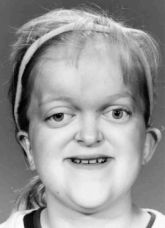Pfeiffer Sydrome: Treatment
Surgery of the Midface:
There are three operations used to bring the mid face forward in Pfeiffer syndrome, the LeFort I, the LeFort III and the monobloc. The LeFort I brings the lower mid face forward, from the nostrils down to the upper teeth. The Le Fort III brings the entire mid face forward, from the cheekbones, and top of the nose, down to the upper teeth. The monobloc brings the mid face and the forehead forward, together at the same operation. There is also a variation of the monobloc, called a bipartition, in which the face is also split down the middle. Your surgeon will discuss what is he or she thinks is best for your child. In general, the LeFort I is not performed until children are in their teenage years; so, the LeFort III and the monobloc are the two operations typically performed in younger children. Some surgeons believe the monobloc is a very good operation for Pfeiffer syndrome. Among the advantages of the monobloc is that the forehead and mid face are brought forward at the same time; saving a child one operation. However, this operation does have a high risk for very serious infections (also CSF leaks from the brain), which is one of the many reasons that most surgeons, including myself, choose to never perform this procedure (see publications #8, 24).
The LeFort III is the most commonly performed operation for treating the mid face in Pfeiffer syndrome. Of all the operations done for Pfeiffer syndrome, this procedure has the greatest effect on improving a child’s appearance. However, it is most commonly performed to treat sleep apnea, or to remove a tracheostomy. I have only two indications for recommending a Le Fort III. The first is obstructive sleep apnea that cannot be treated by any smaller procedure (or to remove a tracheostomy). The second is when appearance becomes an issue for the child (usually between 6 and 8 years old). For a number of reasons I have learned that it is best to not attempt to advance the mid face, with any operation, before 5-years of age. This operation is one of the bigger operations a child will undergo. The Le Fort III procedure is performed through the same incision, on the top of the child’s head, used for the skull operation. The bones of the mid face are cut across the top of the nose, along the floor of the orbit (under the eye), and down the sides of the cheekbones. No scars are put on the child’s face. After the bones are cut, the mid face is moved forward and held in position with bone grafts (taken from the skull) that are held in place with plates and screws. In young children, the teeth are frequently wired together for 4-6 weeks. In older children a LeFort I may be done at the same time as a LeFort III.
Since 1998, I have been using a halo-distraction technique to advance the face. This is a technique that I developed for children with craniosynostosis syndromes that utilizes a device called the RED system, for the LeFort III operation (see publications #17, 2001, and #24, 2005). The device is not actually red, but is purple, and is gets its name for being a rigid external distraction device. It was originally developed in Chicago for use in children with clefts. I chose to use the RED primarily in children, because I believe that it does not offer much for teenagers unless the mid face is too far back to be successfully treated with a standard Le Fort III. With the RED system, the bones of the mid face are basically cut as described above, with some small differences. Then, instead of pulling the mid face forward and filling in the gaps with skull bone, the skin is closed, and a halo is attached to the outside of the skull with 8 to 10 screws. A splint (U-shaped piece of plastic) is attached to the upper teeth (with wires that go inside the upper lip and around the bones of the face) and two wires extend forward from this splint to attach to the halo. The forward pull of the mid face comes from the dental splint. Although some surgeons will place wires through the skin of the face to attach to the bone, I believe that it is completely unnecessary to leave the permanent facial scars caused by these wires, and I keep all scars off the face. The parents, or the child, turn two screws daily, in order to slowly (and painlessly!) bring the mid face forward. The children are allowed to eat soft foods, and may go to school. Eight weeks later the device is removed with a 20 minute anesthetic. One advantage of using the RED device is that it is a smaller operation than the regular Le Fort III, and is better tolerated by the children (compared to those who undergo the traditional technique and need to have their jaws wired shut). The greatest advantage of the RED device is that it enables surgeons to move the mid-face more than three times further forward than is achieved on average with the traditional technique (based on a study done at our center). I am very excited about this relatively new technique and have made many improvements in the way this operation is done, since I first developed this technique in early 1998. So far, I have treated over 75 children with the RED device, but have continued to perform the standard LeFort III in older children.
|
|
|
|
One example of a good result following a RED halo-distraction LeFort III for a patient with Pfeiffer syndrome seen before surgery on the left, and about 3 years postoperatively (middle) and over 6 years postoperatively (right).
|
Other Pfeiffer Syndrome Treatments:
Skull Surgery
| Treating Sleep Apnea
<<more about Pfeiffer
Syndrome
|






